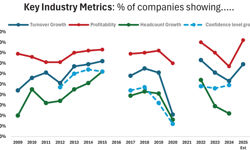I know you’re busy. So this issue, I won’t burden you with one long article. Instead, here are fifteen fun-sized factoids to crisp up your copywriting. Enjoy!
Writing copy in-house
1. If you are fortunate enough to have on your permanent staff a talented copywriter, promoting them to marketing manager will not, generally, improve the quality of copywriting in your business. What it will do is decrease the quality of management in your business. Copywriting is a craft skill, and talented craftsmen and women should be left to get on with their work, not saddled with responsibility for recruiting, supervising, conducting appraisals, and all the baggage that goes with the "manager" tag. Instead, pay them more and give them somewhere quiet to work. (They will then leave you, believing that they will be happier and more fulfilled as a head of copy.)
2. When recruiting marketing executives, the typical ad asking for, "creative and analytical skills, the ability to work on your own and as part of a team, strategic and tactical thinking," is unlikely to furnish you with anyone useful. They will either be suffering from a split personality, or be a congenital liar, since nobody can keep that many impossible things in their head before breakfast and stay sane (not even the Red Queen managed it).
3. Fishing out your pen as soon as your copywriter presents their first draft is not a great motivator. Hey! If you’re that good, how come you don’t write the copy. Believe it or not, your in-house copywriter has put a lot of hard work into that ad, letter or e-mail; show them the courtesy of reading the copy first and thinking about it for a while.
Smart?
4. Putting "to raise awareness" as your primary marketing goal at the top of a copywriting brief is neither particularly smart nor even very helpful. Face it, everyone who sees your mailshot will be aware of your title (assuming you have used the outer envelope to mention it). But, as Gerald Ratner (remember him?) famously discovered, having raised awareness of his company’s products to stellar levels by describing them as "crap" at a meeting with brokers, awareness doesn’t pay the bills. A simple number is usually far more instructive (it certainly focuses my mind, anyway). For example: to sell 500 additional 3-year subscriptions by the end of the year.
5. Refusing to use copy on the outer envelope of a mailshot, on the grounds that, "people will know it’s direct mail," is quite common in my experience. Presumably, these naysayers are the same people who believe you shouldn’t adorn churches with crosses in case people realise they are places of worship, and who can’t see the point of labels on tinned food for similar reasons. There are enough clues on an outer envelope already to suggest that this may just be a mailer. The question is, is it relevant to the reader? Give them a reason to look inside. Use some copy. Or a picture. How about, "How to slide up the greasy pole" for a management title? Or "Eat yourself happy" for a diet mag?
6. We don’t "know" a creative approach won’t work. We are not omniscient. Or psychic. If we are, what the hell are we doing wasting our time in publishing? We could be ruling the world ha, ha haaa. I still have trouble fathoming the thinking of publishers in particular and marketers in general who tell me, quite seriously, that they can predict the psychological and financial responses of a list of 100,000 strangers to a typeface, headline, offer or sales hook and, therefore, need not waste their money on testing. A related attitude can be summed up as, "I never read this type of copy, so I don’t want you to use it." Hmm. I prefer the approach of a client of mine at one of the big London-based magazine publishers. She says, "I hate that copy – keep going, the sales are fantastic."
Training
7. You do not need to hire expensive copywriting trainers to improve the skills of your staff. For a modest outlay of twenty or thirty pounds a head, you could give each of them a handful of books that, if they read them, would sharpen their writing and, more importantly, their salesmanship. But, most people do not read books at all, and especially not business or professional books. I suppose this is good news for people like me. And there IS a difference between reading a book and attending a course. But books are a great first step. Why not, at the very least, acquaint your staff with the thinking and practice of the best people in advertising and marketing over the last 100 years or so?
8. Cheap training is a false economy. If your goal is to tick the box that says, "Attended copywriting training" on your team’s yearly appraisal sheet then of course cheap training is what you want. If, on the other hand, you want to see some sort of return on investment in terms of sales and profits, I would counsel you to seek out the best quality training and compare the cost against the increased revenues you expect it to generate for your titles. If you market £1,595/year management newsletters, why worry if a workshop costs £4,000? Three additional subscriptions will cover your outlay.
9. Great copywriters are not necessarily great trainers. Knowing how to do something and knowing how to communicate that knowledge to others are quite different skills. Why do you think so few tennis coaches ever win Wimbledon? If you DO decide to bring in external trainers, ask about their copywriting experience of course, but much more importantly, ask about their training experience. Ask them how they engage learners (beware of anyone who talks to you about trainees). Ask them what they do to maintain arousal levels after lunch. Ask them what they do to embed learning.
Planning
10. Every piece of copy needs a plan, whether it’s a three-phase banner ad or a long-copy sales letter. Resist the temptation to dive in and start writing. It’s what we call an action illusion. You feel busy because you are writing, but you’re being neither efficient nor effective. And forget about what you want to say. Instead, concentrate on what your reader wants to hear. Make sure you have a clearly defined goal at the head of your plan. I find a quick trip to KFC always helps. Chicken? No. What do you want your reader to Know, Feel and Commit?
11. There are lots of ways to write great copy. But I’ve yet to find a more reliable guide to a sound sales letter – or email – than AIDCA. (You know, Attention, Interest, Desire, Conviction, Action.) Maybe this is old-school. Maybe the digital world works differently. I think not though. At the very least, this age-old formula helps you write a rounded sales pitch that leaves nothing out. Prefer writing story-based copy, or foot-in-the-door? Offer based, or benefits-based? Fine – this works for any style of copy.
12. If you are going to hit your targets for the piece of copy you’re writing, you need to know your reader. Research them, empathise with them, uncover their motivations AND reservations. Remember, copywriting is salesmanship in print so use all the tools that a good salesman would, from objection handling to a strong close.
What works
13. Storytelling is a hugely effective way of conveying sales messages while engaging your reader. Stories don’t have to be long, but they do need to rely on narrative techniques. Give your reader a character, a situation, some action and a resolution, preferably with a twist, and you have them hooked. One of my favourite ads is for Técla jewellers of New York. It was written by Frank Irving Fletcher, the best-paid copywriter of his time. Here it is, in full: "A client for whom we had copied a necklace of Oriental Pearls, seeing both necklaces before her, said: Well, the resemblance is remarkable, but this is mine! Then she picked up ours!"
14. Facts take your copywriting to a sparsely populated region of the salesosphere where your voice carries further. And let’s be clear, by facts I do not mean features. Here are a few examples of what I mean. "Paper Tiger is read by 98,400 of the world’s most successful office stationery sales executives." "Last year, 75% of subscribers to the Brent Report were promoted to the boardroom." "With no external shareholders to please, we are free to pursue a policy of total editorial independence."
15. I feel slightly strange committing this one to print, but experience tells me there are plenty of publishers and marketeers (and especially editors) who struggle with it: features aren’t benefits. I have lost count of the mailpacks and web pages I have seen with a heading, "Fifteen benefits of subscribing" followed by a list of fifteen features. For the record, "in-depth interviews" is NOT a benefit. Nor is "Access to our website". A simple but devastatingly effective tool for turning features into benefits is to ask the old "So what?" question. Keep asking it until you feel foolish for doing so. Remember, too, that whether you are selling to consumers or business people, they are all human (or the majority are). That means they have emotions and emotional reactions to sales pitches. Forget this at your peril.
FEATURE
"Congratulations! Your copy is so good you’re now in charge of marketing."
From a common method of sabotaging in-house writers to a powerful tool for turning features into benefits, Andy Maslen explores fifteen ideas that could put the sparkle back into your copy.










